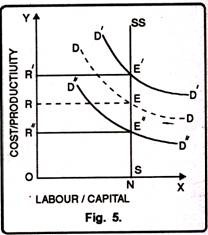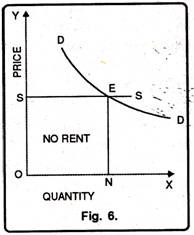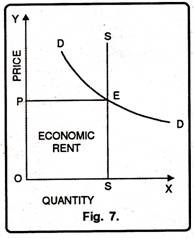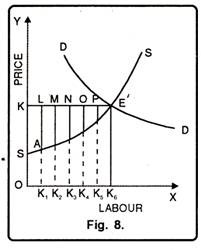Modern theory of rent is an amplified and modified version of Ricardian theory of Rent. It was first of all discussed by J.S. Mill and after that developed by economists like Jevons, Pareto, Marshall, Joan Robinson etc.
According to modern theory, economic rent is a surplus which is not peculiar to land alone. It can be a part of income of labour, capital, entrepreneur.
According to modern version rent is a surplus which arises due to difference between actual earning and transfer earning.
That is:
ADVERTISEMENTS:
Rent = Actual Earning-Transfer Earning.
What is Transfer Earning?
In this universe, each factor of production has varied uses. When we transfer one factor from one use to another, we have to sacrifice the income earned by it from its earlier use. Sacrifice of earning is called transfer earning.
Basically, the concept of transfer earning in economics is introduced by Prof. Benham. According to him, “The amount of money which any particular unit could earn in its best paid alternative use is sometimes called its transfer earnings.” A similar idea was developed by Pigou. Different economists consider transfer earnings as that amount of money which any particular unit could cam in its best paid alternative use.
Thus, what a person, piece of land or capital can earn in the next best alternative use is known as transfer earnings. Thus, according to Mrs. Robinson, “The price which is necessary to retain a given unit of three factors in a certain industry may be called its transfer earning.”
ADVERTISEMENTS:
Suppose a piece of land can cam Rs. 100/- when it is used for producing wheat and the same amount if it is used for cotton. There is no extra earning because there are no transfer earnings. If, however, the same piece of land could cam Rs. 60 when put to the use of cotton.
Its transfer earning would be Rs. 40 and the extra gain of Rs. 40 which is surplus could be called Rent. So, according to this theory, we can define rent as a payment of excess of the transfer earnings. In the words of Benham, “In general the excess of what any unit gets over its transfer earnings is of the nature of rent.” In the above example, true rent is Rs. 10 and transfer earning Rs. 40.
Modern Definitions of Rent:
“Rent is a payment in excess of transfer earning.” Stonier and Hague
“The essence of the conception of rent is the conception of a surplus earned by a particular part of a factor of production over and above the minimum sum necessary to induce it to do its work”. Mrs. Joan Robinson
Features of Modern Theory of Rent:
The major features of the modern theory of rent are as under:
ADVERTISEMENTS:
1. Rent can be a part of the income of all factors of production.
2. Amount of rent depends upon the difference between actual earning and transfer earning.
3. Rent arises when supply of the factor is either perfectly inelastic or less elastic.
Why Rent Arises:
According to modern theory, rent arises due to scarcity of land. Supply of other factors like labour, capital etc. can also be scare in relation to demand. Therefore, income earned by these factors in excess of their minimum income is called economic rent.
Prof. Wieser divided factors of production into two parts viz.; specific factors and nonspecific factors.
Specific Factors:
These factors refer to those factors which have only one use. For example, a farm used for growing wheat alone. Such factors have no mobility.
Non-Specific Factors:
These factors are those which have mobility and can be put to different uses. It is only due to the reason that specific factors cannot be put to another use. Specificity of factors is the main cause of the emergence of rent. It is so because specific factors cannot be put to any other use. So, its opportunity cost is zero. In other words, its transfer earning is zero. So its entire actual earning in the existing use is rent.
Determination of Rent:
Modern economists studied the determination of rent in two forms as:
ADVERTISEMENTS:
1. Rent of Land
2. General concept of Rent.
Determination of Rent of Land or Scarcity Theory of Rent:
Modern economists opined that rent arises due to scarcity of land. Scarcity of land means that demand for land exceeds its supply. Rent will be determined at a point where demand for land is equal to its supply.
Demand for Land:
Land has derived demand. It means that demand for land depends on the demand for agricultural products. If demand for food grains increases, demands for land will also increase and vice-versa. Moreover, demand for land is influenced by its marginal productivity. It means as more and more land is used its MP1 goes on diminishing.
Supply of Land:
ADVERTISEMENTS:
Supply of land is fixed. Its supply is perfectly inelastic. It means, increase in the price of land will not evoke any increase in its supply.
In Fig. 5 units of land have been measured on X-axis and rent on Y-axis. SS is the supply curve of land which is parallel to Y-axis indicating that the supply of land remains fixed. Rent will be determined at a point where the demand and supply of land are equal to each other.
Initially DD is the demand curve which intersects the supply curve at point E. At this point, equilibrium rent OR is determined. Now, if the population rises which gives boost to the demand for food, the demand curve shifts to D’D’ and the equilibrium will be at point E’ and the rent will rise to the extent of OR’.
ADVERTISEMENTS:
Similarly, if the demand curve shifts to D” D” and labour /capital the new equilibrium point will be E” and the rent will fall to OR”.
Rent as the Difference between Actual Earnings and Transfer Earnings:
According to modern economists rent is the difference between actual earning and transfer earning. Rent can be a part of income of factors of production. But, these factors will earn rent only when their supply is less than perfectly elastic.
Thus, from elasticity point of view, there are three possibilities, i.e.:
1. Supply of factors of production is perfectly elastic.
2. Supply of factors of production is perfectly inelastic.
3. Supply of factors of production is less than perfectly elastic.
(i) When Supply is Perfectly Elastic:
ADVERTISEMENTS:
When change in demand at existing rate is followed by corresponding change in supply, then the supply is said to be perfectly elastic i.e. such a factor is not scare. At the existing rate, any amount of that factor is available. Therefore, its actual earning and transfer earning will be equal.
Actual Earning = Transfer Earning Rent
= Actual Earning – Transfer Earning = Zero
In Fig 6 the supply curve of the factor of production is represented by SS which is horizontal straight line. It means all factors are available at price OS. DD is the demand curve.
The demand and supply curves intersect each other at point E. ON is the quantity of the factor used and price is OS. The total earnings are OSEN.
ADVERTISEMENTS:
Since, transfer earnings are equal to actual earnings i.e. OSEN, there is no surplus and, thus, no rent. If this firm does not pay the price, the factor units will be shifted to other uses and earn there as much, because present earnings equates the transfer earnings. In this way, we may conclude that if the supply is perfectly elastic, then there exists no surplus and hence no economic rent.
(ii) When the Supply is Inelastic:
Inelastic supply of a factor indicates that any increase or decrease in demand is not followed by the supply. In such a case, transfer earnings will be zero and the difference between actual earning and transfer earning will be equal to actual earning. Therefore, all the actual earnings will be called rent.
Rent = Actual Earning (Since Transfer Earning is zero)
In Figure 7, SS is perfectly inelastic supply curve of land which indicates that if price of land falls to zero even then supply remains OS. It means the transfer earnings of land are zero.
DD is the demand curve. As both the demand and supply curves intersect each other at point E, price OP is determined. Since transfer earnings are zero, the total earnings (OSEP) represent the economic rent.
(iii) When the Supply is Less than Perfectly Elastic:
Less than perfectly elastic supply means that the transfer earnings of all the factor units are not equal. Mrs. Joan Robinson used the concept of ‘Transfer Earnings’ to explain the amount of rent earned by a factor unit in a particular use. She defines transfer earnings as the price which is necessary to retain a given unit of a factor in a certain industry.
This can be shown with the help of the following table 2:
The above table shows that when demand for labourer is 20, their transfer earning and actual earnings are equal. Therefore, Rs. 20 is the minimum wage rate below which there will be no supply of labour. Now, if demand for labourer increases to 35 but supply does not increase to the same ratio, wage rate will rise. As a result actual earning of labourer will rise to 25 while transfer earning will be Rs. 20 per labourer. Similarly, if the demand for labourer increases to 40 but supply does not rise, wage rate of labourer will further rise. Actual earning will go upto Rs. 30 per labourer. Thus, every labourer will earn rent equal to Rs. 10.
In Fig. 8 labour has been measured on X-axis and price on Y-axis. SS is the somewhat elastic but not perfectly elastic supply curve indicating that what quantity of the factor will be available at various prices. The transfer earning of X1 unit of factor is AK1 while the price is OK.
Thus the surplus or rent is AL. In the same fashion, the other unit earns surplus or rent. The transfer earnings of each factor units are less than the price. All units except the last unit Kg are earning profits which are more than their transfer earnings i.e. they are earning economic rent. The total earnings are OK6E’ K and the transfer earnings are OK6E’. If we take away the transfer earnings, we get KE’S as surplus or rent.




